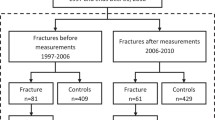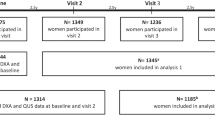Abstract
Summary
In this cross-sectional study, 95 postmenopausal women, with and without fracture history, were measured by low-frequency axial transmission ultrasound. The measured ultrasound velocity discriminated the fractured subjects from the nonfractured ones equally or better than peripheral quantitative computed tomography (pQCT) and dual energy x-ray absorptiometry (DXA). These results suggest that low-frequency ultrasound is suitable for bone fragility assessment.
Introduction
Quantitative low-frequency axial transmission ultrasound is a promising modality for assessing mineral density and geometrical properties of long bones such as radius and tibia. The aim of the current study was to evaluate the ability of low-frequency axial transmission ultrasound to discriminate fractures retrospectively in postmenopausal women.
Methods
A cross-sectional study involved 95 female subjects aged 45–88 years, whose fracture information was gathered retrospectively. The fracture group was defined as subjects with one or more low-/moderate-energy fractures. The radius and tibial shaft were measured with a custom-made ultrasonometer to assess the velocity of the low-frequency first-arriving signal (V LF). Site-matched pQCT was used to measure volumetric cortical and subcortical bone mineral density (sBMD), and cortical thickness (CTh). Areal BMD (aBMD) was measured using DXA for the whole body (WB), lumbar spine, and hip.
Results
The majority (19/32; 59 %) of the fractures were in the upper limb. V LF in the radius, but not in the tibia, discriminated fractures with an age- and BMI-adjusted odds ratio (OR) of 2.06 (95 % CI 1.21–3.50, p < 0.01). In the radius, CTh and cortical BMD (CBMD) significantly discriminated fractures, as did the total, cortical, and sBMD in the tibia (adjusted OR 1.35–2.15, p < 0.05). Sensitivity and specificity were similar among all the measurements (area under the receiver operating characteristic curve 0.74–0.81, p < 0.001).
Conclusions
Low-frequency axial transmission ultrasound in the radius was able to discriminate fractured subjects from the nonfractured ones. This suggests that low-frequency axial transmission ultrasound has the potential to assess bone fragility in postmenopausal women.


Similar content being viewed by others
References
Kanis JA (2002) Diagnosis of osteoporosis and assessment of fracture risk. Lancet 359:1929–1936
Griffith JF, Genant HK (2008) Bone mass and architecture determination: state of the art. Best Pract Res Clin Endocrinol Metab 22:737–764
Schuit SC, van der Klift M, Weel AE, de Laet CE, Burger H, Seeman E, Hofman A, Uitterlinden AG, van Leeuwen JP, Pols HA (2004) Fracture incidence and association with bone mineral density in elderly men and women: the Rotterdam Study. Bone 34:195–202
Stone KL, Seeley DG, Lui LY, Cauley JA, Ensrud K, Browner WS, Nevitt MC, Cummings SR, Osteoporotic Fractures Research Group (2003) BMD at multiple sites and risk of fracture of multiple types: long-term results from the Study of Osteoporotic Fractures. J Bone Miner Res 18:1947–1954
Bouxsein ML (2006) Biomechanics of osteoporotic fractures. Clin Rev Bone Miner Metab 4:143–153
Glüer CC (2008) A new quality of bone ultrasound research. IEEE Trans Ultrason Ferroelectr Freq Control 55:1524–1528
Glüer CC, Eastell R, Reid DM, Felsenberg D, Roux C, Barkmann R, Timm W, Blenk T, Armbrecht G, Stewart A, Clowes J, Thomasius FE, Kolta S (2004) Association of five quantitative ultrasound devices and bone densitometry with osteoporotic vertebral fractures in a population-based sample: the OPUS Study. J Bone Miner Res 19:782–793
Krieg MA, Cornuz J, Ruffieux C, Van Melle G, Büche D, Dambacher MA, Hans D, Hartl F, Häuselmann HJ, Kraenzlin M, Lippuner K, Neff M, Pancaldi P, Rizzoli R, Tanzi F, Theiler R, Tyndall A, Wimpfheimer C, Burckhardt P (2006) Prediction of hip fracture risk by quantitative ultrasound in more than 7000 Swiss women > or =70years of age: comparison of three technologically different bone ultrasound devices in the SEMOF study. J Bone Miner Res 21:1457–1463
Marin F, Gonzalez-Macias J, Diez-Perez A, Palma S, Delgado-Rodriguez M (2006) Relationship between bone quantitative ultrasound and fractures: a meta-analysis. J Bone Miner Res 21:1126–1135
Stegman MR, Heaney RP, Travers-Gustafson D, Leist J (1995) Cortical ultrasound velocity as an indicator of bone status. Osteoporos Int 5:349–353
Foldes AJ, Rimon A, Keinan DD, Popovtzer MM (1995) Quantitative ultrasound of the tibia: a novel approach for assessment of bone status. Bone 17:363–367
Hans D, Srivastav SK, Singal C, Barkmann R, Njeh CF, Kantorovich E, Glüer CC, Genant HK (1999) Does combining the results from multiple bone sites measured by a new quantitative ultrasound device improve discrimination of hip fracture? J Bone Miner Res 14:644–651
Bossy E, Talmant M, Peyrin F, Akrout L, Cloetens P, Laugier P (2004) An in vitro study of the ultrasonic axial transmission technique at the radius: 1-MHz velocity measurements are sensitive to both mineralization and intracortical porosity. J Bone Miner Res 19:1548–1556
Sarvazyan A, Tatarinov A, Egorov V, Airapetian S, Kurtenok V, Gatt CJ Jr (2009) Application of the dual-frequency ultrasonometer for osteoporosis detection. Ultrasonics 49:331–337
Kilappa V, Moilanen P, Xu L, Nicholson PH, Timonen J, Cheng S (2011) Low-frequency axial ultrasound velocity correlates with bone mineral density and cortical thickness in the radius and tibia in pre- and postmenopausal women. Osteoporos Int 22:1103–1113
Weiss M, Ben-Shlomo A, Hagag P, Ish-Shalom S (2000) Discrimination of proximal hip fracture by quantitative ultrasound measurement at the radius. Osteoporos Int 11:411–416
Talmant M, Kolta S, Roux C, Haguenauer D, Vedel I, Cassou B, Bossy E, Laugier P (2009) In vivo performance evaluation of bi-directional ultrasonic axial transmission for cortical bone assessment. Ultrasound Med Biol 35:912–919
Bossy E, Talmant M, Laugier P (2002) Effect of bone cortical thickness on velocity measurements using ultrasonic axial transmission: a 2D simulation study. J Acoust Soc Am 112:297–307
Nicholson PH, Moilanen P, Kärkkäinen T, Timonen J, Cheng S (2002) Guided ultrasonic waves in long bones: modelling, experiment and in vivo application. Physiol Meas 23:755–768
Barkmann R, Kantorovich E, Singal C, Hans D, Genant HK, Heller M, Glüer CC (2000) A new method for quantitative ultrasound measurements at multiple skeletal sites: first results of precision and fracture discrimination. J Clin Densitom 3:1–7
Njeh CF, Saeed I, Grigorian M, Kendler DL, Fan B, Shepherd J, McClung M, Drake WM, Genant HK (2001) Assessment of bone status using speed of sound at multiple anatomical sites. Ultrasound Med Biol 27:1337–1345
Moilanen P, Nicholson PH, Kärkkäinen T, Wang Q, Timonen J, Cheng S (2003) Assessment of the tibia using ultrasonic guided waves in pubertal girls. Osteoporos Int 14:1020–1027
Raum K, Leguerney I, Chandelier F, Bossy E, Talmant M, Saïed A, Peyrin F, Laugier P (2005) Bone microstructure and elastic tissue properties are reflected in QUS axial transmission measurements. Ultrasound Med Biol 31:1225–1235
Raum K, Cleveland RO, Peyrin F, Laugier P (2006) Derivation of elastic stiffness from site-matched mineral density and acoustic impedance maps. Phys Med Biol 51:747–758
Määttä M, Moilanen P, Nicholson P, Cheng S, Timonen J, Jämsä T (2009) Correlation of tibial low-frequency ultrasound velocity with femoral radiographic measurements and BMD in elderly women. Ultrasound Med Biol 35:903–911
Völgyi E, Tylavsky FA, Xu L, Lu J, Wang Q, Alén M, Cheng S (2010) Bone and body segment lengthening and widening: a 7-year follow-up study in pubertal girls. Bone 47:773–782
Kärkkäinen M, Tuppurainen M, Salovaara K, Sandini L, Rikkonen T, Sirola J, Honkanen R, Jurvelin J, Alhava E, Kröger H (2010) Effect of calcium and vitamin D supplementation on bone mineral density in women aged 65–71years: a 3-year randomized population-based trial (OSTPRE-FPS). Osteoporos Int 21:2047–2055
Pakarinen M, Raitanen J, Kaaja R, Luoto R (2010) Secular trend in the menopausal age in Finland 1997–2007 and correlation with socioeconomic, reproductive and lifestyle factors. Maturitas 66:417–422
McLellan AR, Gallacher SJ, Fraser M, McQuillian C (2003) The fracture liaison service: success of a program for the evaluation and management of patients with osteoporotic fracture. Osteoporos Int 14:1028–1034
Bossy E, Talmant M, Defontaine M, Patat F, Laugier P (2004) Bidirectional axial transmission can improve accuracy and precision of ultrasonic velocity measurement in cortical bone: a validation on test materials. IEEE Trans Ultrason Ferroelectr Freq Control 51:71–79
Miller CG, Herd RJ, Ramalingam T, Fogelman I, Blake GM (1993) Ultrasonic velocity measurements through the calcaneus: which velocity should be measured? Osteoporos Int 3:31–35
Orgee JM, Foster H, McCloskey EV, Khan S, Coombes G, Kanis JA (1996) A precise method for the assessment of tibial ultrasound velocity. Osteoporos Int 6:1–7
Wang Q, Alén M, Nicholson P, Lyytikäinen A, Suuriniemi M, Helkala E, Suominen H, Cheng S (2005) Growth patterns at distal radius and tibial shaft in pubertal girls: a 2-year longitudinal study. J Bone Miner Res 20:954–961
Cheng S, Lyytikäinen A, Kröger H, Lamberg-Allardt C, Alén M, Koistinen A, Wang QJ, Suuriniemi M, Suominen H, Mahonen A, Nicholson PH, Ivaska KK, Korpela R, Ohlsson C, Väänänen KH, Tylavsky F (2005) Effects of calcium, dairy product, and vitamin D supplementation on bone mass accrual and body composition in 10–12-y-old girls: a 2-y randomized trial. Am J Clin Nutr 82:1115, 26; quiz 1147-8
Hanley JA, McNeil BJ (1983) A method of comparing the areas under receiver operating characteristic curves derived from the same cases. Radiology 148:839–843
Augat P, Fan B, Lane NE, Lang TF, LeHir P, Lu Y, Uffmann M, Genant HK (1998) Assessment of bone mineral at appendicular sites in females with fractures of the proximal femur. Bone 22:395–402
Granke M, Grimal Q, Saïed A, Nauleau P, Peyrin F, Laugier P (2011) Change in porosity is the major determinant of the variation of cortical bone elasticity at the millimeter scale in aged women. Bone 49:1020–1026
Yeni YN, Brown CU, Wang Z, Norman TL (1997) The influence of bone morphology on fracture toughness of the human femur and tibia. Bone 21:453–459
Zebaze RM, Ghasem-Zadeh A, Bohte A, Iuliano-Burns S, Mirams M, Price RI, Mackie EJ, Seeman E (2010) Intracortical remodelling and porosity in the distal radius and post-mortem femurs of women: a cross-sectional study. Lancet 375:1729–1736
Knapp KM, Blake GM, Spector TD, Fogelman I (2001) Multisite quantitative ultrasound: precision, age- and menopause-related changes, fracture discrimination, and T-score equivalence with dual-energy X-ray absorptiometry. Osteoporos Int 12:456–464
Nguyen TV, Center JR, Eisman JA (2004) Bone mineral density-independent association of quantitative ultrasound measurements and fracture risk in women. Osteoporos Int 15:942–947
Hans D, Genton L, Allaoua S, Pichard C, Slosman DO (2003) Hip fracture discrimination study: QUS of the radius and the calcaneum. J Clin Densitom 6:163–172
Pepe MS, Janes H, Longton G, Leisenring W, Newcomb P (2004) Limitations of the odds ratio in gauging the performance of a diagnostic, prognostic, or screening marker. Am J Epidemiol 159:882–890
Report of a WHO Scientific Group (ed) (2003) Prevention and management of osteoporosis, WHO technical report series, no. 921. World Health Organisation, Geneva
Acknowledgments
This work was supported by the Academy of Finland (project nos. 133183 and 130826), the Finnish Funding Agency for Technology and Innovation (Tekes, project nos. 2572/31/06 and 40463/05), and Infotech Oulu Doctoral Programme. The authors thank Risto Bloigu, MSc, for assistance with statistics.
Conflicts of interest
None.
Author information
Authors and Affiliations
Corresponding author
Additional information
P. Moilanen and M. Määttä These authors had equal contribution.
Rights and permissions
About this article
Cite this article
Moilanen, P., Määttä, M., Kilappa, V. et al. Discrimination of fractures by low-frequency axial transmission ultrasound in postmenopausal females. Osteoporos Int 24, 723–730 (2013). https://doi.org/10.1007/s00198-012-2022-x
Received:
Accepted:
Published:
Issue Date:
DOI: https://doi.org/10.1007/s00198-012-2022-x




